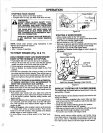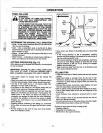
OPERATION
:23_
/
TREE FELLING
WARNING:
IF THE TRUNK OR LIMBS ARE ROTTING,
THEY CAN FALL UNEXPECTEDLY AND
CAUSE SERIOUS INJURY,
AS YOU MAKE YOUR FELLING CUT, IF THE
SAW APPEARS TO BE BINDING, THE TREE
IS STARTING TO FALL IN THE WRONG
DIRECTION, IMMEDIATELY STOP THE SAW
AND USE A FELLING WEDGE AND MAUL
oHAMMER) TO FORCE THE FELLING CUT
PEN. THE WEDGE WILL HOLD THE
FELLING CUT OPEN ALLOWING YOU TO
REMOVETHE SAW.KEEP EVERYONE AWAY
FROM THE TREE IN ALL DIRECTIONS.
DETERMINE THE NATURAL FALL DIRECTION
• Wind - A tree evenlybalanced willfall in the samedirec-
tionthe wind is btowing.
• Lean - Use a carpenter's levelor plumb bob to deter-
mine if tree has a naturallean.A leaningtree willtendto
fall in direction of lean.
• Shape - Atree willtend to fail towardsside thatismore
heavily branched.
• Other Factors- Contactingor nearby trees, buildings,or
wires can influencethe directionthe tree wiltfall.
CUTTING PROCEDURE (Fig. 12)
Afterdetermining the Natural FallDirection,the treeshould
be cutas follows:
IMPORTANT: BEFORE FELLING A TREE, MAKE SURE
YOU HAVE AT LEAST 3 FELLING WEDGES AND A
MAUL (HAMMER) AVAILABLEFOR USE IF NEEDED.
• Use some means to visually mark the Natural Fall
Direction.
* Mark your notch cuton the Natural Fall Directionside of
the tree approximately 18-24 inches above theground.
• Cut top of the notch first at a 45 degree angle. Saw
through 1/3 of the widthof the tree.
• Cut bottom of the notchat a 45 degree angle untilyou
meet the top notchcut. Remove notchof wood.
• On the side of the tree opposite the notchcut, makethe
fellingcut. The felling cut shouldbe 2 inches above the
center point of the notch cut. Before the felting cut is
complete, use wedges to open the cut when necessary
to control the direction of the fall. Use wood or plastic
wedges, but never steel or iron, to avoid kickbackand
chain damage.
• Cracking sounds, widening of the felling cut, movement
in the upper branches are all signs that the treeis ready
to fall.
• As tree begins to fall, turn off saw, and move quickly
away from directionof fall
Felling._Direction _2" 1 S_I_
Top i g
Notch_
cut
Bottom
Notch
Cut /3 _ Buttress
\ °oo,
Figure 12
If your chain saw binds in the felling cut, you have three
options:
• If the wrong direction of fall is acceptable, carefully
remove the felling wedge. C_ deeper in the notchside of
the tree untiltree starts to fall.
• Ifthe wrong directionof fall is not acceptable,attemptto
use one or more felling wedges to force the tree in the
original direction of fall. Do so by driving the wedges
deeper intothe fellingcut.
• Keep everyone away from the tree in all directions and
•then seek professionalhelp!
FELLING TIPS
• Clear the work area of debriswhere youcan havesecure
footing.
• Make sure there is enough room for the tree to fall.
Maintain a distance of 2 1/2 tree lengths from the near-
est person or other objects.Engine noise can drown out
a warning call.
• Remove dirt, stones, loose bark, nails, staples, and wire
from the tree where cutsare to be made.
• Plan to stand on the up-hill side when cuttingon a slope.
• Plan a clear retreat path to the rear and diagonal to the
line of fall.
• Large buttress roots should be removed priorto notch
CUt.
" Use a wedge if there is any chance that the tree willnot
fall in the desired direction.
• We recommend you cut branches below shoulder height
before felling tree. (See Limbing and Pruning).
Be alert to signs that the tree is ready to fall:
• Cracking sounds.
• Widening of the felling cut.
° Movement in the upper branches.


















